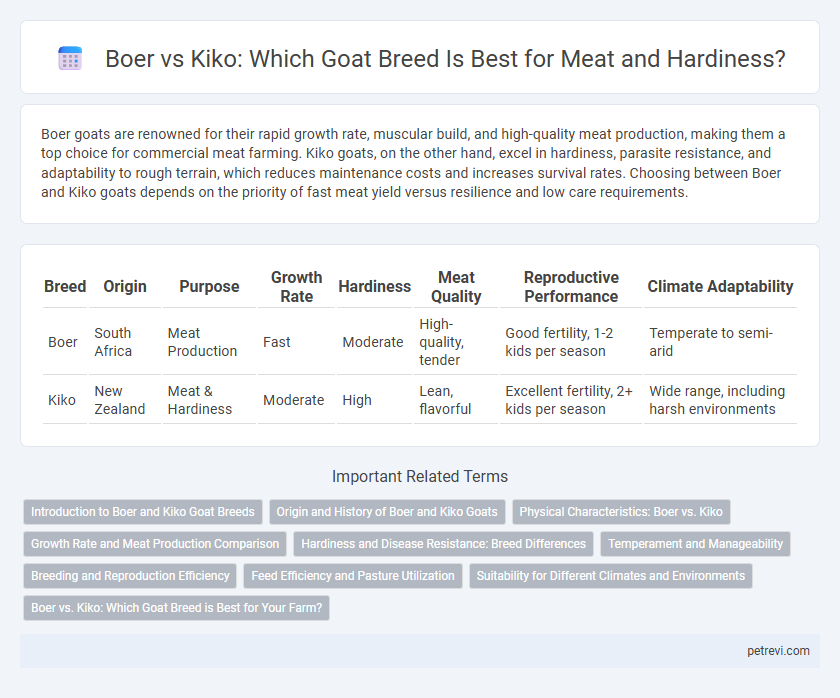Boer goats are renowned for their rapid growth rate, muscular build, and high-quality meat production, making them a top choice for commercial meat farming. Kiko goats, on the other hand, excel in hardiness, parasite resistance, and adaptability to rough terrain, which reduces maintenance costs and increases survival rates. Choosing between Boer and Kiko goats depends on the priority of fast meat yield versus resilience and low care requirements.
Table of Comparison
| Breed | Origin | Purpose | Growth Rate | Hardiness | Meat Quality | Reproductive Performance | Climate Adaptability |
|---|---|---|---|---|---|---|---|
| Boer | South Africa | Meat Production | Fast | Moderate | High-quality, tender | Good fertility, 1-2 kids per season | Temperate to semi-arid |
| Kiko | New Zealand | Meat & Hardiness | Moderate | High | Lean, flavorful | Excellent fertility, 2+ kids per season | Wide range, including harsh environments |
Introduction to Boer and Kiko Goat Breeds
Boer goats, originating from South Africa, are renowned for their rapid growth rate and muscular build, making them a top choice for meat production globally. Kiko goats, developed in New Zealand, are prized for their hardiness, parasite resistance, and ability to thrive in harsh grazing conditions. Both breeds offer distinct advantages, with Boer goats excelling in meat yield and Kiko goats providing superior survivability and low-maintenance care.
Origin and History of Boer and Kiko Goats
Boer goats originated in South Africa during the early 1900s, selectively bred for meat production and adaptability to harsh climates. Kiko goats were developed in New Zealand in the late 1980s by crossing local feral goats with imported dairy and meat goats to enhance hardiness and growth rates. Both breeds reflect targeted efforts to improve meat yield and environmental resilience, with Boer goats emphasizing rapid growth and Kiko goats focusing on parasite resistance and low-maintenance traits.
Physical Characteristics: Boer vs. Kiko
Boer goats exhibit a robust, muscular build with a distinctive red head and white body, known for their broad chest and strong legs designed for meat production. Kiko goats have a leaner frame with a predominantly white or light-colored coat, featuring hardy hooves and a thicker hide that enhance their ability to withstand rugged terrain and harsh climates. The Boer's compact and heavy-set physique contrasts with the Kiko's taller, more agile form, reflecting their different breeding goals of rapid growth versus resilience and adaptability.
Growth Rate and Meat Production Comparison
Boer goats exhibit rapid growth rates, reaching market weight faster than Kiko goats, making them highly efficient for meat production. Kiko goats, while slightly slower in growth, are prized for their hardiness and lower maintenance, which can translate to consistent meat yields in challenging environments. Overall, Boer goats are preferred for intensive meat production systems, whereas Kiko goats excel in extensive farming with reliable growth and sustainability.
Hardiness and Disease Resistance: Breed Differences
Boer goats exhibit moderate hardiness but are more susceptible to certain diseases compared to Kiko goats, which are renowned for their exceptional disease resistance and ability to thrive in harsh environments. Kiko goats have been selectively bred in New Zealand to withstand parasites, foot rot, and poor forage conditions, offering superior longevity and lower veterinary costs. Conversely, Boer goats, prized for rapid growth and meat quality, require more attentive management to mitigate health risks.
Temperament and Manageability
Boer goats are known for their docile temperament, making them easier to handle and ideal for beginners in goat farming. Kiko goats exhibit a hardy and independent nature, requiring less intervention but needing experienced handlers to manage their assertive behavior. Both breeds offer distinct advantages in manageability depending on the farmer's experience and operation goals.
Breeding and Reproduction Efficiency
Boer goats exhibit rapid growth rates and high fertility, making them a preferred choice for meat production and breeding programs focused on reproductive efficiency. Kiko goats, known for their hardy nature and strong maternal instincts, often demonstrate higher kid survival rates and lower maintenance requirements in extensive breeding systems. Both breeds offer distinct advantages in reproductive efficiency, with Boer excelling in growth and Kiko in resilience and adaptability.
Feed Efficiency and Pasture Utilization
Boer goats exhibit strong feed efficiency, converting high-energy feeds into rapid muscle growth, making them popular for meat production. Kiko goats, however, excel in pasture utilization due to their hardiness and ability to thrive on low-quality forage, reducing feed costs significantly. Selecting between Boer and Kiko breeds depends on balancing intensive feeding strategies with extensive pasture management goals.
Suitability for Different Climates and Environments
Boer goats excel in hot, arid climates due to their robust heat tolerance and resistance to parasites, making them ideal for regions with harsh, dry conditions. Kiko goats thrive in humid, subtropical environments because of their strong forage-grazing ability and exceptional parasite resistance, which supports their adaptability to dense vegetation and wetter climates. Both breeds offer unique advantages for different environmental challenges, with Boer goats favored for meat production in dry areas and Kiko goats suited for rugged terrains with variable climates.
Boer vs. Kiko: Which Goat Breed is Best for Your Farm?
Boer goats excel in rapid growth and high-quality meat production, making them a top choice for farmers focused on profitability and market demand. Kiko goats offer superior hardiness and parasite resistance, thriving in harsh conditions with lower maintenance requirements. Choosing between Boer and Kiko depends on your farm's climate, management style, and goal to maximize either meat yield or sustainability.
Boer vs Kiko for Goat Breed Infographic

 petrevi.com
petrevi.com